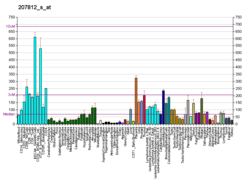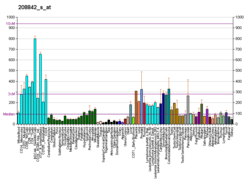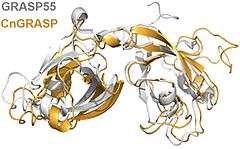GRASP55
| GORASP2 | |||||||||||||||||
|---|---|---|---|---|---|---|---|---|---|---|---|---|---|---|---|---|---|
| |||||||||||||||||
| Identifiers | |||||||||||||||||
| Aliases | GORASP2, GOLPH6, GRASP55, GRS2, p59, golgi reassembly stacking protein 2 | ||||||||||||||||
| External IDs | OMIM: 608693 MGI: 2135962 HomoloGene: 9180 GeneCards: GORASP2 | ||||||||||||||||
| |||||||||||||||||
| RNA expression pattern | |||||||||||||||||
   | |||||||||||||||||
| More reference expression data | |||||||||||||||||
| Orthologs | |||||||||||||||||
| Species | Human | Mouse | |||||||||||||||
| Entrez | |||||||||||||||||
| Ensembl | |||||||||||||||||
| UniProt | |||||||||||||||||
| RefSeq (mRNA) | |||||||||||||||||
| RefSeq (protein) | |||||||||||||||||
| Location (UCSC) | Chr 2: 170.93 – 170.97 Mb | Chr 2: 70.66 – 70.71 Mb | |||||||||||||||
| PubMed search | [1] | [2] | |||||||||||||||
| Wikidata | |||||||||||||||||
| |||||||||||||||||
Golgi reassembly-stacking protein of 55 kDa (GRASP55) also known as golgi reassembly-stacking protein 2 (GORASP2) is a protein that in humans is encoded by the GORASP2 gene.[3][4] It was identified by its homology with GRASP65 and the protein's amino acid sequence was determined by analysis of a molecular clone of its complementary DNA.[3] The first (N-terminus) 212 amino acid residues of GRASP55 are highly homologous to those of GRASP65, but the remainder of the 454 amino acid residues are highly diverged from GRASP65.[3] The conserved region is known as the GRASP domain, and it is conserved among GRASPs of a wide variety of eukaryotes, but not plants.[4][5] The C-terminus portion of the molecule is called the SPR domain (serine, proline-rich).[5] GRASP55 is more closely related to homologues in other species, suggesting that GRASP55 is ancestral to GRASP65.[5] GRASP55 is found associated with the medial and trans cisternae of the Golgi apparatus.[5]
Function

GRASP55 is involved in establishing the structure of the Golgi apparatus.[5][4] It is a peripheral membrane protein located on the Golgi cisterna, and it can bind to another GRASP55 located on an adjacent cisterna through the GRASP domain, thus linking the cisternae together through multiple protein–protein interactions.[5][6]
GRASP55 is attached to the membrane in two ways; it is myristylated, which attaches it directly to the lipid bilayer; it is also bound indirectly by binding to golgin-45, which binds to a Rab protein, which itself is lipidated and thus anchored to the membrane.[5]
The structure of the Golgi is disrupted during mitosis, and phosphorylation of the SPR domains of GRASP55 and GRASP65 regulate that disruption,[7][6] GRASP55 may also be involved in forming Golgi ribbons, but the evidence is mixed.[5][7]
Other interactions
GRASP55 has been shown to interact with TGF alpha,[8] TMED2[8] and GOLGA2.[3][8][9]
References
- ↑ "Human PubMed Reference:".
- ↑ "Mouse PubMed Reference:".
- 1 2 3 4 Shorter J, Watson R, Giannakou ME, Clarke M, Warren G, Barr FA (September 1999). "GRASP55, a second mammalian GRASP protein involved in the stacking of Golgi cisternae in a cell-free system". The EMBO Journal. 18 (18): 4949–60. PMC 1171566
 . PMID 10487747. doi:10.1093/emboj/18.18.4949.
. PMID 10487747. doi:10.1093/emboj/18.18.4949. - 1 2 3 "Entrez Gene: GORASP2 golgi reassembly stacking protein 2, 55kDa".
- 1 2 3 4 5 6 7 8 Zhang X, Wang Y (2015). "GRASPs in Golgi Structure and Function". Frontiers in Cell and Developmental Biology. 3: 84. PMC 4701983
 . PMID 26779480. doi:10.3389/fcell.2015.00084.
. PMID 26779480. doi:10.3389/fcell.2015.00084. - 1 2 Zhang, Xiaoyan; Wang, Yanzhuang (6 January 2016). "GRASPs in Golgi Structure and Function". Frontiers in Cell and Developmental Biology. doi:10.3389/fcell.2015.00084.
- 1 2 Xiang Y, Wang Y (January 2010). "GRASP55 and GRASP65 play complementary and essential roles in Golgi cisternal stacking". The Journal of Cell Biology. 188 (2): 237–51. PMC 2812519
 . PMID 20083603. doi:10.1083/jcb.200907132.
. PMID 20083603. doi:10.1083/jcb.200907132. - 1 2 3 Barr FA, Preisinger C, Kopajtich R, Körner R (December 2001). "Golgi matrix proteins interact with p24 cargo receptors and aid their efficient retention in the Golgi apparatus". The Journal of Cell Biology. 155 (6): 885–91. PMC 2150891
 . PMID 11739402. doi:10.1083/jcb.200108102.
. PMID 11739402. doi:10.1083/jcb.200108102. - ↑ Short B, Preisinger C, Körner R, Kopajtich R, Byron O, Barr FA (December 2001). "A GRASP55-rab2 effector complex linking Golgi structure to membrane traffic". The Journal of Cell Biology. 155 (6): 877–83. PMC 2150909
 . PMID 11739401. doi:10.1083/jcb.200108079.
. PMID 11739401. doi:10.1083/jcb.200108079.
Further reading
- Maruyama K, Sugano S (January 1994). "Oligo-capping: a simple method to replace the cap structure of eukaryotic mRNAs with oligoribonucleotides". Gene. 138 (1-2): 171–4. PMID 8125298. doi:10.1016/0378-1119(94)90802-8.
- Suzuki Y, Yoshitomo-Nakagawa K, Maruyama K, Suyama A, Sugano S (October 1997). "Construction and characterization of a full length-enriched and a 5'-end-enriched cDNA library". Gene. 200 (1-2): 149–56. PMID 9373149. doi:10.1016/S0378-1119(97)00411-3.
- Kuo A, Zhong C, Lane WS, Derynck R (December 2000). "Transmembrane transforming growth factor-alpha tethers to the PDZ domain-containing, Golgi membrane-associated protein p59/GRASP55". The EMBO Journal. 19 (23): 6427–39. PMC 305863
 . PMID 11101516. doi:10.1093/emboj/19.23.6427.
. PMID 11101516. doi:10.1093/emboj/19.23.6427. - Jesch SA, Lewis TS, Ahn NG, Linstedt AD (June 2001). "Mitotic phosphorylation of Golgi reassembly stacking protein 55 by mitogen-activated protein kinase ERK2". Molecular Biology of the Cell. 12 (6): 1811–7. PMC 37343
 . PMID 11408587. doi:10.1091/mbc.12.6.1811.
. PMID 11408587. doi:10.1091/mbc.12.6.1811. - Short B, Preisinger C, Körner R, Kopajtich R, Byron O, Barr FA (December 2001). "A GRASP55-rab2 effector complex linking Golgi structure to membrane traffic". The Journal of Cell Biology. 155 (6): 877–83. PMC 2150909
 . PMID 11739401. doi:10.1083/jcb.200108079.
. PMID 11739401. doi:10.1083/jcb.200108079. - Barr FA, Preisinger C, Kopajtich R, Körner R (December 2001). "Golgi matrix proteins interact with p24 cargo receptors and aid their efficient retention in the Golgi apparatus". The Journal of Cell Biology. 155 (6): 885–91. PMC 2150891
 . PMID 11739402. doi:10.1083/jcb.200108102.
. PMID 11739402. doi:10.1083/jcb.200108102. - Lane JD, Lucocq J, Pryde J, Barr FA, Woodman PG, Allan VJ, Lowe M (February 2002). "Caspase-mediated cleavage of the stacking protein GRASP65 is required for Golgi fragmentation during apoptosis". The Journal of Cell Biology. 156 (3): 495–509. PMC 2173349
 . PMID 11815631. doi:10.1083/jcb.200110007.
. PMID 11815631. doi:10.1083/jcb.200110007. - Beausoleil SA, Villén J, Gerber SA, Rush J, Gygi SP (October 2006). "A probability-based approach for high-throughput protein phosphorylation analysis and site localization". Nature Biotechnology. 24 (10): 1285–92. PMID 16964243. doi:10.1038/nbt1240.
- Olsen JV, Blagoev B, Gnad F, Macek B, Kumar C, Mortensen P, Mann M (November 2006). "Global, in vivo, and site-specific phosphorylation dynamics in signaling networks". Cell. 127 (3): 635–48. PMID 17081983. doi:10.1016/j.cell.2006.09.026.